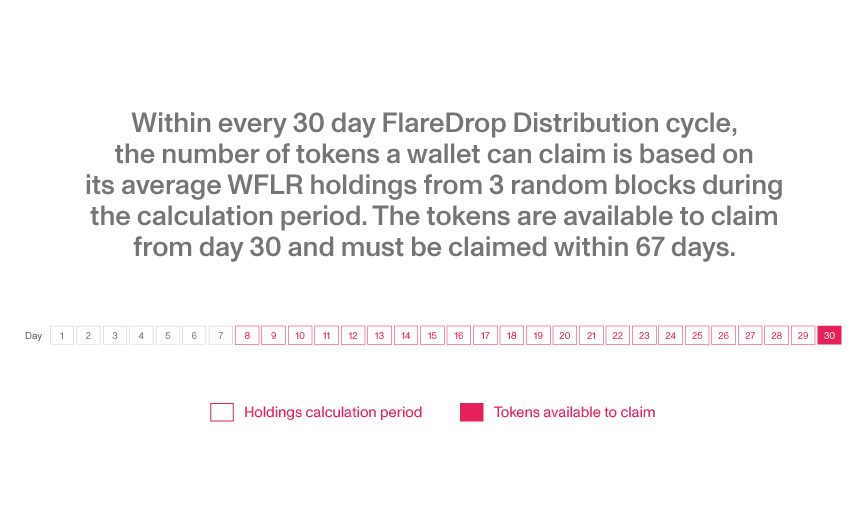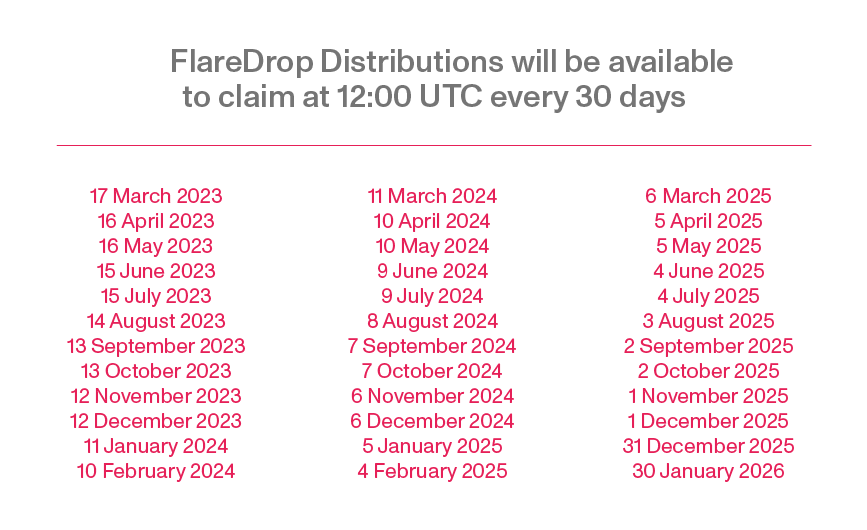The Flare community has approved the first Flare Improvement Proposal with a 93% majority and a 17% voter turnout. FIP.01 was designed to better align Flare’s tokenomics with the ambitions of the Foundation to address blockchain’s utility and interoperability issues. The first of the 36 FlareDrop Distributions will be available to claim on 17 March.
New method for the FlareDrop Distribution
The distribution was initially intended for users who held XRP in December 2020. They were to receive 15% in an initial distribution, and the rest over 36 months without any further action required.
The initial 15% distribution was completed during the Flare Token Distribution Event on 9 January, but following the approval of FIP.01, the remaining 85% of the distribution will instead be shared by all holders of wrapped FLR.
As per the original plan, this will still be split into 36 installments: 35 installments of 676,040,637 FLR and one final installment of 584,760,888 FLR. Combined with the initial 15% distribution, this totals 28,524,921,372 FLR to be provided directly to the Flare community.
Every 30 days, each installment will be proportionally allocated to wallets that hold wrapped FLR (WFLR). The tokens must be claimed within 67* days or they will be burned.
To define the amount due to each wallet, the mean WFLR balance will be calculated based on 3 random blocks chosen from the 23 days prior to distribution day. The received FLR will then be proportional to this average as a percentage of the total circulating WFLR.
For example, if a wallet contains an average of 0.001% of the total circulating supply of WFLR across the three random blocks, then the wallet will be eligible for 0.001% of the next distribution allocation, which equals 6760.4 FLR.
These tokens will need to be actively claimed by every user, just like the FTSO delegation rewards, for example by using the Flare Portal. However, Flare recently deployed facilities for safe automatic claiming by third parties, allowing users to “set and forget”. These facilities have already been leveraged by some wallets to offer autoclaiming functionality for FTSO rewards. It is likely providers will offer similar functionality to autoclaim the public token distribution.

The expected benefits of this new distribution method are:
- It removes the reliance on centralized exchanges for future distributions. If the initial recipient wallets were in custody, for example in an exchange, users would not have access to the tokens until the custodian decided to release them. It also puts users at risk of future token loss if their exchange suffers financial issues. With the new on-chain method, users can select where they want to receive their tokens. Any wallet that has held WFLR during the 23 days prior to distribution day will be eligible to claim a share of that installment.
- It broadens access to the distribution and allows Flare-connected communities to also benefit, which means more ecosystems have an incentive to grow and participate with Flare.
- Only active network participants who are holding WFLR will receive future distributions. This will result in a transfer of tokens from people who are not interested in Flare as a project or a community, to those who want to participate or contribute.
Reduced inflation
Inflation on the Flare network was previously set at 10% of the fully diluted supply, in perpetuity. It has now been changed to be 10% of the available circulating supply in the first year, 7% in the second, and 5% in the third year and onwards, plus it is capped at 5B FLR per year. This means that over time inflation trends towards 0% of tokens. The direct benefit is a less inflationary token.
The allocation of the monthly inflation to the different parties supporting the network has also been adjusted. Each month, 70% of the inflation amount will be provided to Flare Time Series Oracle data providers and shared with the FLR token holders who have delegated to them. The network validators then receive 20% and State Connector attestation providers receive 10%.
Implementation timetable
The first of the 36 distributions will take place on Friday 17 March at 12:00 UTC. WFLR holdings will be calculated based on three random blocks from the previous 23 days. Subsequent distributions will happen every 30 days. 
The Flare team are not eligible for the FlareDrop Distributions
No Flare related entity, employee or founder may use their token allocation to earn part of the token distribution. Every team member has signed a legal agreement to ensure that this does not happen and will actively opt-out their wallet from the distribution. This means any WFLR in Flare team wallets will not be factored into the distribution calculation and these wallets will not be able to claim any FLR from the FlareDrop Distributions.
*Previously this article said there were 90 days to claim FlareDrop tokens before they are burned. The 90 days starts at the beginning of the Holdings calculation period, which mean users have 67 days to claim each FlareDrop Distribution.
